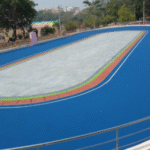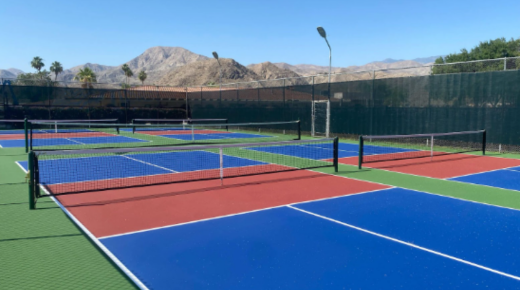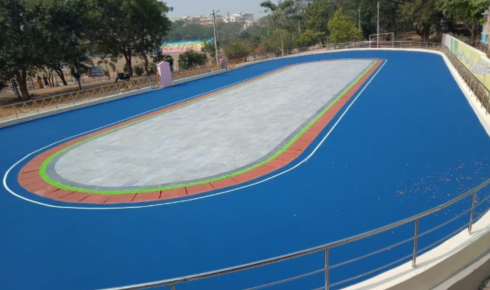Pickleball is rapidly gaining popularity across the globe. Whether you’re constructing a new court or refurbishing an existing one, choosing the right pickleball court materials is crucial for ensuring long-term durability and a great playing experience. One of the most important decisions in this process is selecting the ideal pickleball court flooring. The right flooring can enhance the speed, bounce, and overall performance of the game, making it a key factor in court construction and maintenance.
In this blog, we’ll dive into the various pickleball court materials, what to consider when selecting pickleball court flooring, and the role of pickleball court manufacturers and pickleball court resurfacing in maintaining the court’s quality.
Why the Right Pickleball Court Materials Matter
The right pickleball court materials will not only impact the look of the court but also influence the playing experience. For players, the floor’s surface affects the ball’s bounce, their footwork, and overall comfort. For facility owners or sports clubs, durable flooring is a long-term investment that will endure frequent use, weather elements, and wear over time.
Pickleball court materials are specially designed to withstand heavy foot traffic, outdoor conditions, and the fast-paced nature of the game. The most common flooring options are made from synthetic materials, including acrylic, rubber, and polyurethane. These surfaces offer superior performance, durability, and safety features, making them a top choice for both professional and recreational pickleball courts.
Types of Pickleball Court Flooring
When selecting the right pickleball court flooring, it’s essential to consider the surface that will best suit the court’s purpose, whether it’s for competitive play, recreational use, or a combination of both. Below are some of the most common pickleball court materials used for flooring:
1. Acrylic Flooring
Acrylic flooring is one of the most popular pickleball court materials because of its durability, smooth finish, and versatility. It offers a reliable balance between speed and control, providing an ideal playing surface for both indoor and outdoor pickleball courts. Acrylic flooring is resistant to UV rays, ensuring it maintains its color and texture even with prolonged exposure to sunlight. It’s also easy to maintain, requiring only routine cleaning and occasional resurfacing to keep the court in excellent condition.
2. Rubber Flooring
For facilities seeking a cushioned surface that minimizes joint stress, rubber flooring is an excellent choice. While not as commonly used for competitive play, it can provide a comfortable surface for recreational players. Rubber courts also have the added benefit of being slip-resistant, which can be crucial for safety, especially for players of all ages and skill levels.
3. Polyurethane Flooring
Another popular pickleball court material is polyurethane flooring. Known for its shock-absorbing properties, polyurethane flooring provides a softer surface, which helps reduce the impact on joints during intense gameplay. While polyurethane is often more expensive than acrylic, its resilience and ability to handle heavy use make it an ideal option for busy facilities.
The Importance of Choosing Experienced Pickleball Court Manufacturers
Selecting the right pickleball court manufacturers is key to ensuring that the court is constructed to the highest standards. Experienced manufacturers not only provide quality pickleball court materials but also offer expert advice on which materials are best suited to the specific needs of your court.
A reputable manufacturer will guide you in selecting the ideal flooring that meets both performance and durability requirements. They will also ensure proper installation techniques, ensuring the flooring is applied correctly for long-lasting results. When choosing pickleball court manufacturers, consider factors such as their reputation in the industry, their experience with building pickleball courts, and their ability to provide ongoing maintenance and resurfacing services.
Pickleball Court Resurfacing: Maintaining Court Quality Over Time
Even the best pickleball court materials require maintenance over time to keep the court in optimal condition. This is where pickleball court resurfacing comes into play. Regular resurfacing helps prevent wear and tear, extending the life of the court and ensuring it remains safe and playable for years to come.
During resurfacing, the court’s surface is thoroughly cleaned and repaired, with new layers of pickleball court materials applied to restore its performance. For acrylic courts, this might involve applying a fresh coat of acrylic paint to restore the surface’s color and texture. For other surfaces, such as rubber or polyurethane, resurfacing may involve filling cracks, smoothing uneven spots, and applying a protective layer to preserve the flooring.
Resurfacing is particularly important for outdoor courts, where exposure to the elements can cause the surface to degrade more quickly. Regular pickleball court resurfacing will help keep the court safe and playable while improving its aesthetic appeal.
How to Choose the Right Pickleball Court Flooring
Choosing the right pickleball court flooring depends on several factors, including the climate, usage frequency, and the level of play. Here’s what to consider when making your decision:
- Durability: How often will the court be used? High-traffic courts, such as those in public parks or recreational centers, will need durable flooring that can withstand constant use. Acrylic or polyurethane are excellent choices for high-traffic courts.
- Climate: If the court is outdoors, consider how the flooring will hold up against weather conditions. Acrylic and rubber are great choices for outdoor courts because they resist UV damage and are highly weather-resistant.
- Performance: For competitive play, select a flooring that provides consistent ball bounce and traction. Acrylic surfaces are preferred for professional-level competitions due to their predictable bounce and high performance.
- Budget: Flooring options vary in price. Acrylic is a more affordable option, while polyurethane flooring may come at a higher cost due to its added shock absorption and durability.
Conclusion
Investing in the right pickleball court materials is crucial for ensuring a high-quality, durable, and safe playing surface. Whether you’re building a new court or resurfacing an existing one, selecting the best pickleball court flooring is essential for creating a great playing experience. Working with experienced pickleball court manufacturers and investing in regular pickleball court resurfacing will ensure that your court remains in top condition for years to come.
By choosing the right flooring materials and working with the right professionals, you can enjoy a superior pickleball experience every time you step onto the court.









